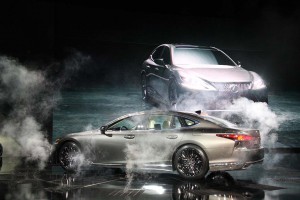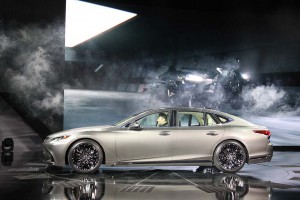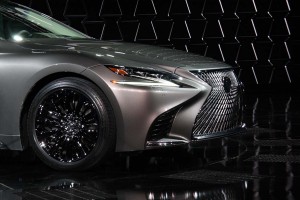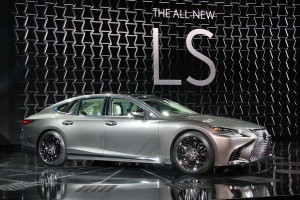When the original Lexus LS made its debut at the 1989 North American International Auto Show, it stood the luxury automotive market on its head. Now the Japanese automaker is back at the NAIAS and hoping that the fifth-generation remake of its flagship sedan will once again set an industry benchmark.
But things have changed dramatically in the intervening years, and the question is whether the new 2018 Lexus will have the relevancy of the original, despite all its refinement and features and a design that is far more cutting edge than almost any other Lexus product before it.
“It is the car that launched a company,” said Jeff Bracken, the U.S. manager of the Lexus brand, as the 2018 LS sedan rolled onto the stage at Detroit’s Cobo Center.
The LS clearly needed a makeover. For one thing, it was the oldest industry in the premium luxury market. And times have changed dramatically since it first hit the road. For one thing, competitors like the Mercedes-Benz S-Class, BMW 7-Series and Audi A8 have made significant upgrades in technology.

The new LS flagship features high- and ultra-high-strength steel to improve ride and handling as well fuel economy.
They’ve also opted for more exciting and distinctive designs than the staid, classic cruisers of the past. So, Lexus designers created several thousand sketches before settling on the dramatic look that rolled onto the stage during a standing-room-only preview at this year’s NAIAS.
The new LS picks up on the mandate laid down by parent Toyota Motor Corp. CEO Akio Toyoda who, in a visit to Cobo Center last January, declared Lexus would put more “passion” into both its design and driving dynamics.
The 2018 Lexus LS certainly lives up to that promise from a visual standpoint. It abandons the traditionally boxy Lexus look for a more coupe-like design. It picks up on the brand’s familiar “spindle grille,” but here it gets a jewel-like appearance by crafting a full 5,00 surfaces into its spokes, noted Bracken.
The cabin, meanwhile, adopts an array of premium and high-tech features. There’s a new infotainment system with expanded levels of connectivity, and the world’s largest, 24-inch head-up display to help drivers keep their eyes on the road.

The original LS came equipped with a V8, but that's been replaced with a more powerful twin-turbo V6.
Though it retains the classic leather and wood cues of a luxury car, the interior adopts a more chic and elegant appearance than the outgoing LS. One of the more intriguing design details is the integration of door armrests that appear to be floating on their own.
Comfort is, of course, a watchword for halo luxury cars, and the new 2018 LS shouldn’t disappoint. For the driver, there’s a 28-way heated and cooled seat with optional Shiatsu massage. The rear seats recline and can also be equipped with optional heating and massage functionality.
(Forget sedans; Audi Q8 Concept reveals where luxury is really heading. Click Here for the story.)
Lexus, like sibling brand Toyota, has been putting a premium on luxury and it expands the array of advanced driver assistance systems, or ADAS technologies available on the 2018 LS. That includes a world’s first collision avoidance system that not only can detect and brake for pedestrians but, if necessary, even steer out of the way of a collision.

The new Lexus LS, while not necessarily thought of as a race car, will do 0 to 60 mph in 4.5 seconds.
Picking up on broader trends in the premium luxury segment, the new LS walks away from its traditional V-8 powertrain in favor of a high-tech, twin-turbo V-6 – mated to a segment-first 10-speed automatic transmission — making 415 horsepower and 442 pound-feet of torque. That’s enough to launch the big sedan from 0 to 60 in just 4.5 seconds, according to Bracken.
A hybrid version is expected to follow, though Lexus didn’t offer details. And while it said the twin-turbo six will deliver better mileage than the old V-8, final numbers won’t be released until closer to launch.
Under the skin, the 2018 Lexus LS shares the same new Global Architecture-Luxury platform first used for the brand’s high-performance LC coupe – which was launched at the NAIAS last January. The GA-L, as Lexus calls it, adopts new high- and ultra-high-strength steel to shave about 200 pounds of mass off from the old LS. That approach also results in a stiffer, more nimble ride, Bracken said, and is another reason why fuel economy should improve notably.

Lexus designers were instructed to liven up the design of the LS and the new-look flagship shows they did.
(Click Here to see how Donald Trump is stealing the Detroit Auto Show.)
Despite the new design, the more aggressive driving dynamics and the array of new features and technologies, the question remains whether that all matters. The premium luxury sedan market has been steadily losing momentum in recent years. All told, vehicles like the LS, S-Class, A8 and 7-Series generated collective sales of barely 80,000 vehicles worldwide last year.
Like the mainstream automotive market, luxury buyers are rapidly migrating from passenger cars to light trucks. As a result, several company insiders acknowledged the new Lexus LS simply won’t have the impact of the original. And that’s forcing the marque to give serious thought to its future strategy.
Rival Audi showed how it’s adapting to a changing industry with the launch of the Q8 Concept at the Detroit Auto Show. The production version of the show car, due out next year, will be the utility vehicle alternative to the A8.
Lexus does have the big LX570 SUV, but in current form it really isn’t an LS alternative. So, brand planners are looking at ways to make it more relevant. One question is whether to shift from the current LX body-on-frame platform to a more car-like crossover approach, ala the Audi Q8.
(To see the new Honda Odyssey, Click Here.)
There is little question that the new Lexus LS is a visually striking, technologically impressive automobile. It retains the right to be called a flagship. But as the industry continues to evolve, Lexus will have to consider the likelihood it will need two flagships going forward.

